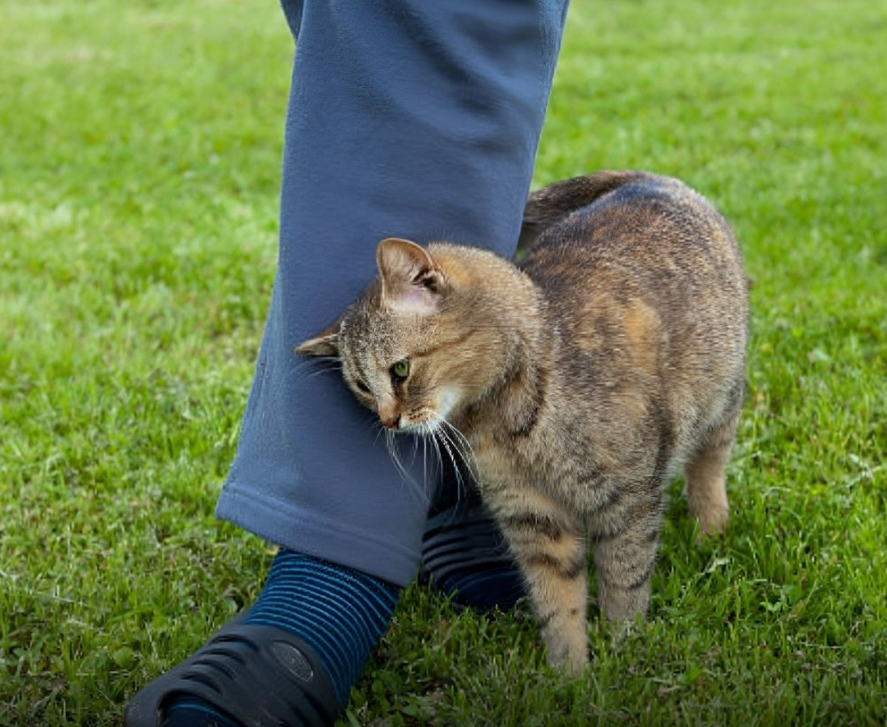If you share your home with a cat, you’ve likely experienced those quiet, tender moments when your feline companion gently rubs against your leg, arm, or even your face. At first glance, it might seem like a small, routine gesture — but in the world of cats, this behavior carries a wealth of meaning. Understanding it can deepen your bond, enrich your relationship, and make your cat feel genuinely loved and secure. These seemingly subtle touches are, in fact, profound communications of trust and affection.
1. Understand What It Really Means
When a cat rubs against you, it’s not merely asking for attention — it’s communicating on multiple levels. Cats have specialized scent glands located on their cheeks, forehead, chin, and base of their tails. When your cat rubs against your body, it’s leaving its scent behind. This is both a territorial behavior and a social gesture. Essentially, your cat is marking you as a trusted member of its social circle.
In simpler terms, your cat is saying: “You’re part of my world, and I trust you completely.” It’s a profound compliment. Unlike dogs, who often demonstrate affection through obvious excitement, cats are more subtle and deliberate in their gestures. That gentle nuzzle is a signal of emotional safety and belonging — and recognizing that makes every moment of contact more meaningful.
2. Respond with Gentle Touch
The most effective way to return a cat’s affection is through soft, calm petting. Begin by stroking areas cats generally love: the top of the head, under the chin, around the ears, and along the back. These spots correspond to areas with the highest concentration of nerve endings and scent glands, making them especially pleasurable for cats.
Avoid the belly unless your cat explicitly invites it. Many cats instinctively protect their midsection because it houses vital organs, and unexpected touches there can trigger defensive reactions.
When you respond to your cat’s rubs, you’re not just giving a physical pat — you’re reinforcing a bond of trust. This simple exchange conveys: “I accept you, I care for you, and I respect your presence.” It strengthens the emotional connection, making your cat feel secure in sharing these tender moments with you.
3. Speak Softly and Reassuringly
Cats are highly attuned to tone of voice. A calm, gentle, and warm vocal presence can have an immediate soothing effect. Phrases like “Hey, sweetheart,” “Good kitty,” or even soft humming can help your cat associate your presence with comfort and safety.
It’s not the specific words that matter, but the warmth behind them. Cats read energy, tone, and intent much more than they process literal language. Your calm, reassuring voice tells them that their trust is well-placed — that your home is a safe, secure space where they can relax and be themselves.
4. Pay Attention to Context
Not every rub carries the same message. The context can provide important clues about your cat’s needs or intentions:
Greeting after absence: If your cat rubs against you after you return home, it’s expressing joy at seeing you and reaffirming the bond.
Request for attention: When combined with a meow or a nudge toward their food or toys, your cat might be asking for interaction, meals, or playtime.
Seeking comfort: If it occurs while you’re seated quietly, your cat may be seeking reassurance or closeness, signaling that it values your presence and wants to feel emotionally connected.
Being observant about these subtleties helps you understand your cat’s emotional state and respond in a way that strengthens trust and affection.
5. Respect Your Cat’s Boundaries
Even though the impulse to scoop your cat up for a hug can be strong, most cats prefer affection on their own terms. If your cat rubs you once and then walks away, respect that choice. In their world, that brief contact has already conveyed significant meaning.
Cats deeply value autonomy. Respecting their boundaries not only prevents stress or anxiety but also reinforces your role as a safe and considerate companion. Over time, this respect leads to more voluntary displays of affection and a deeper mutual trust.
6. Build Positive Habits
Every time your cat rubs against you and you respond gently and calmly, you reinforce a positive behavioral pattern. Your cat learns that approaching you leads to pleasant, safe interactions. This repeated cycle nurtures confidence, emotional security, and strengthens the human-feline bond.
Positive reinforcement doesn’t require treats or toys; simply acknowledging your cat’s affectionate gesture with a soft pet or calm voice is enough to make them feel valued and safe. Over months and years, these small acts cultivate a profound sense of connection.
Final Thoughts
When a cat rubs against you, it’s offering far more than a touch. It’s a message of trust, a demonstration of affection, and a way of claiming you as part of its world. As a cat owner, your role is to honor and respond to this communication:
Gently pet your cat: Focus on areas they enjoy most.
Speak softly: Use a calm, reassuring voice to convey safety and warmth.
Respect boundaries: Allow your cat to choose how and when it expresses affection.
Remember, for a cat, that simple rub is their way of saying: “I trust you. I love you. With you, I am safe.” Each gentle nuzzle is a quiet, yet profound, expression of the deep bond that exists between you and your feline companion. By paying attention, responding thoughtfully, and respecting your cat’s signals, you create a shared language of affection that grows stronger with every touch.
